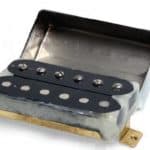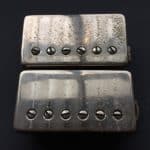Pickups are of paramount importance.
They are in charge of capturing and turning string vibrations into sound.
At least, they are part of such a process.
However, any tool can get damaged and stop working properly.
One of the things that could happen to your pickups is that they turn into microphonic pickups.
The question is: What are microphonic pickups exactly?
When someone says a guitar pickup is microphonic, it means that it starts working similar to a microphone. In other words, instead of perceiving string vibrations solely, they also start taking outside sounds. As a consequence, the final sound a guitar produces is affected by external noises.
There is no doubt about it: microphonic pickups are the worst thing that could happen to a guitar, isn’t it?
Well, not really.
If you want to know why, then keep on reading, because microphones pickups have certain advantages too.
What does “microphonic” mean for guitar pickups?
To say that a guitar pickup goes microphonic is to say that the pickup starts working as a microphone.
This means that instead of only reproducing the signal coming from the instrument, the pickups also take acoustic and unwanted sounds from the outside.
As a result, a hybrid of noises will be created every time you play.
Let’s provide a more detailed explanation.
Guitar pickups convert string vibration into sound. This vibration passes through the pickups and ends up coming out boosted from either an amplifier or a speaker.
Now, what’s good about guitar pickups is that they are designed in a way that can only perceive the vibration of the strings.
How does that work?
Well, pickups don’t have other components moving (unlike microphones).
This makes it almost impossible to perceive outside noises.
However, it might happen that a guitar pickup becomes microphonic.
In other words, the pickups’ shape is disturbed, thus, allowing for the taking of external forces.
As a result, it ends up transforming and boosting such external sounds.
All in all, this affects and changes the music produced with your guitar.
Is this something good? Is this something bad?
Keep on reading to find it out!
How to tell if your pickups became microphonic?
The best way to know whether a guitar pickup becomes microphonic or not is by hearing.
For example, you’ll notice those unwanted sounds I mentioned before or any change in sound at all.
You can also check by adding tons of gain and screaming in front of the pickups.
If your voice comes out from the speaker as if it was a normal microphone, then it is a clear sign that the pickups became microphonic.
Here’s a video that shows the differences in sound between one and the other.
I recommend this one too, which provides a vivid example of all the things I mentioned before.
Are microphonic pickups something bad?
With all the information mentioned before, one could come up with a logical conclusion:
Microphonic pickups are bad.
Think about it. Your guitar’s sound has changed.
Playing won’t feel the same way as it used to be anymore.
It’s a shame, isn’t it?
Well, truth is, it depends on your personal preferences.
Sure, distorted, unwanted sounds bursting out from your speaker can be unbearable.
However, there are cases in which such distortion will come in handy.
If you enjoy vintage sounds, or if you want your band to sound vintage, then a microphonic pickup will do a fine job.
Is there any tonal benefit from pickups being microphonic?
The main benefit of having microphonic pickups is, ironically, their damaged sound.
Again, many bands that look for a vintage sound need such dirty and almost oppressive sounding.
Some bands demand distortion, and microphonic pickups cover that demand.
What is more, microphonic pickups detect a wider amount of noise.
Instead of just perceiving and transforming the vibration of the strings, a microphonic pickup could boost the percussive sound of your pick, or the tapping, or muting of your palm against the fret.
All in all, it detects and records sounds that otherwise would pass unnoticed.
For some people, it is better to keep such noises hidden.
For others, they allow for a world of possibilities.
Are microphonic pickups fixable?
We have seen both advantages and disadvantages of having microphonic pickups.
If you prefer sticking with its advantages, then enjoy your new sound and push it to the limit!
Now, you may not be content with this sound and you want to fix the pickups.
If that’s the case, then there’s a way to fix your instrument.
Of course, it costs money and should be done by a professional.
However, the solution is guaranteed.
I’m talking about wax potting pickups.
Does wax potting help with microphonic pickups?
As the name says, wax potting (also known as wax winding) consists of adding wax pot to the pickups.
Wax here helps to minimize the microphonic feedback from the pickups, providing more definition to the overdrive tones.
This is made by inhibiting the movement of the coils. Remember that feedback is caused by sound waves moving freely within the magnetic field.
Wax then, reduces the possibility of movement, therefore, it reduces unwanted sounds.
Unfortunately, there’s a disadvantage to adding wax to your pickups.
Too much wax leads to a “muddy” sound which makes for cleaner tones more difficult to obtain.
Consider this information before deciding the fate of your guitar.
Are there off-the-shelf microphonic pickups to buy?
Apparently, it is not possible to buy microphonic pickups in a store.
If anything, one could opt to buy a Vintage ReIssued electric guitar.
After all, microphonic pickups help to provide vintage-style sounds.
You could also buy a guitar with P90 pickups. Although it is technically not the same, it gets pretty close.
In conclusion, it seems that the only way to get a guitar with actual microphonic pickups is simply to let time pass by.
However, it’s likely that there are some boutique pickup manufacturers out there that have nailed the microphonic tone for some of their products.
Conclusion
Regular pickups turning into microphonic seems like a terrible thing to happen.
However, we have already learned that this is not the case on every occasion.
Some musicians may realize that having microphonic pickups actually provide newer ways of making music.
Some others may curse and yearn for their older pickups. For those, luckily, wax potting could be the solution.
Either one or the other, I sincerely hope this article has helped you to understand more about this topic.

Hello there, my name is Ramiro and I’ve been playing guitar for almost 20 years. I’m obsessed with everything gear-related and I thought it might be worth sharing it. From guitars, pedals, amps, and synths to studio gear and production tips, I hope you find what I post here useful, and I’ll try my best to keep it entertaining also.





